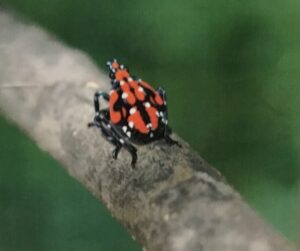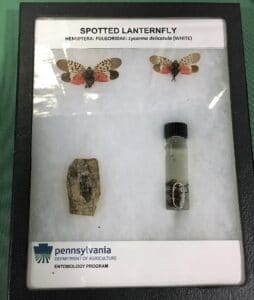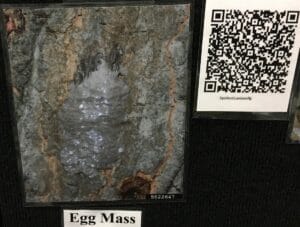Hello fellow readers, As I took photos of a landscape renovation I designed for clients in Tranquility, NJ, I came upon a Spotted Lanternfly that landed on the welcome mat by the front door. I snagged a photo of it, thinking to myself, you are not welcome at all. Since The Press (NJ/PA) ran a front-page photo alert titled Stop Them in Their Tracks, many of you have asked about the dilemma.
About Spotted Lanternfly
Primarily a planthopper, though they can fly, the attractive adults are about an inch long with black heads, black-spotted greyish wings, and bodies that appear to have a reddish glow. The wingless nymphs, which hatch in spring, are black with white spots about a quarter inch then grow to about a half-inch turning red with white spots.
Spotted Lanternfly (SLF) lay their eggs from fall until winter, preferably on the non-native invasive Tree of Heaven (Ailanthus altissima). However, any smooth surface such as rocks, cars, trailers, outdoor furniture, RVs, and farm equipment will do. Hence the rapid spread across counties that could quickly become across states.
First sighted in Pennsylvania in 2014 – Now in five states.
Since the first sighting in 2014 outside of Philadelphia, they are now in twenty-six counties in PA and eight in NJ. You cannot move things like lumber, firewood, construction or plant debris, nursery stock, or cut trees out of the quarantined counties without an SLF Permit from the NJ or PA Department of Agriculture. The Spotted Lanternfly has also been sighted in Maryland, Delaware, Virginia, and West Virginia.
Per the NJ Department of Agriculture (NJDA), don’t contact them if you see the Spotted Lanternfly in the quarantined counties of Burlington, Camden, Gloucester, Hunterdon, Mercer, Salem, Somerset, or Warren. Beyond those counties, they ask that you email or call (slf-plantindustry@ag.nj.gov / 609-406-6943). In PA, report your sightings online to the PA Department of Agriculture or call Penn State Extension at 1-888-4BADFLY (1-888-422-3359). For those of you in other states, contact your local Department of Agriculture to determine if sightings should be reported.
Why Spotted Lanternfly is of BIG concern
Beyond reporting sightings, kill the critters when you can. In their countries of origin, China, India, and Vietnam, they have natural predators and pathogens that control the populations. Not so here. Praying mantises and some spiders are known to eat a few, but not enough to make a dent.
The phloem-feeding bug with piercing mouthparts sucks branches of plants, including hardwood and fruit trees, grapes, blueberries, and hops, devastating them. One farmer explained that while SLF doesn’t yet eat apples as they do grapes, they feed on the terminal end growth, which sets the fruit buds for next year.
What to do to limit the spread of Spotted Lanternfly
Each female lays thirty to fifty eggs in each of three egg masses. Whoa! We all can do our part by removing the yellowish-brown waxy egg masses, especially on vehicles before traveling. Scrape them into a zip lock bag filled with alcohol or hand sanitizer and toss them in the trash.
The Penn State Extension website has a nifty tutorial on ‘How to Build a New Style SLF Circle Trap,’ which is safer than sticky bands wrapped around trees to capture nymphs in the spring. Sadly, sticky bands can capture birds and other creatures too. Removing the invasive Tree of Heaven trees is another suggested remedy.
The NJDA website lists pesticides that homeowners can consider. My preferred safe for the environments go-to’s such as Neem Oil, natural Pyrethrins, Insecticidal Soap, and Spinosad (Bonide Captain Jack’s Dead Bug Brew) are on the list.
Most important is to prevent these expert hijackers from moving on. Maybe the reduction in vacation road trips due to the coronavirus will help keep the critter from traveling beyond our states? Hey, a bit of something good from something sad. Garden Dilemmas? AskMaryStone@gmail.com (and now on your favorite Podcast App.)
Link to Penn State Extension’s How to Build a New Style SLF Circle Trap and About Tree of Heaven
A previous column, as reported at the 2018 NJ Plants Show – Dreaded Spotted Lanternfly.






